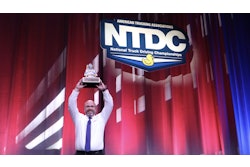
New research by a trucking organization outlines the challenges of replacing the industry’s changing – and aging – driving workforce and offers suggestions on how to address the continuing issues of ecruitment and retention.
Evolving Truck Driver Demographics: Issues and Opportunities from the American Transportation Research Institute says, “The trucking industry is undergoing a significant demographic shift, reflecting broader societal, market, and U.S. labor force changes. As the current truck driver workforce nears retirement, the industry faces both a challenge and unique opportunity: to resupply its ranks by actively engaging younger, more diverse, and historically underrepresented populations.”
According to the report, the average American trucker is 47 years old and the number of driver retirements is accelerating. ATRI said its research “emphasizes the need to modernize recruitment messaging to better resonate with younger generations.” The organization added that its research “provides a roadmap to help carriers enhance recruitment, improve retention, and build a more resilient driver workforce.”
According to ATRI’s research, Generation X (those born between 1965 and 1980) represents 40.8% of truck drivers – the most represented generation. Baby Boomers (born between 1946 and 1964) account for 20.7% of the driver workforce.
As Boomers move toward retirement (typically aged 67), ATRI said the industry must continue to find strategies to connect with both Millennial (1981 - 1995) drivers, who account for 30.7% of drivers, and Generation Z (1996-2010) drivers, 7.5% of drivers.
ATRI’s findings also suggest that among the segments of the population that could potentially help meet the needs of the industry’s driving corps are women, individuals in or who have gone through the foster care system, and those who the report calls “justice-Involved Individuals”, or those who have criminal records.
ATRI’s report includes detailed suggestions on how the trucking industry can attract people in those demographic categories, and how to recruit younger drivers.
To successfully recruit more women to be drivers, ATRI's report suggests:
Provide mentorship and industry support
- Whether through an industry association, an internal company initiative, or a local network, mentorship programs for women not only expand the workforce but also strengthen professional connections and support systems.
Address facility and safety concerns
- Improve access to safe truck stop facilities, ensure cab designs accommodate women, and implement company policies that foster an inclusive and supportive work environment. 2024 ATRI research lays out an industry action plan to meet the needs and preferences of women truck drivers.
Leverage strong safety records
- Research from ATRI consistently shows that women truck drivers demonstrate safer driving behaviors, reinforcing their value as a crucial and reliable workforce asset.
To successfully attract those who have been part of the foster care system, ATRI’s reports suggests:
Host targeted job fairs with guaranteed training and placement
- Organize career events specifically for foster youth, offering on-the-spot interviews, paid CDL training, and clear job placement pathways. This helps bridge the gap between interest and access.
Offer paid internships and entry-level roles in trucking operations
- Create after-school, weekend, or summer jobs in logistics, dispatch, or fleet maintenance. These roles introduce foster youth to the industry early and build a foundation for long-term careers behind the wheel or in support roles.
Build CDL training pipelines through foster care partnerships
- Partner with foster care transition programs and workforce boards to offer CDL training, mechanical skills, and job readiness support. These pipelines can help youth aging out of care access stable, well-paying careers in trucking.
Share success stories to inspire and destigmatize
- Highlight former foster youth who have built successful trucking careers, like those in Table 8. Their stories can challenge stereotypes, inspire others, and show that trucking is a viable path to independence and financial stability.
And, to attract people with criminal records, ATRI’s suggestions include:
Expand second-chance CDL training
- Partner with correctional systems and nonprofits to offer CDL training before or immediately after release.
Develop clear, tiered hiring guidelines
- Use data-driven frameworks to assess candidate suitability based on conviction type and time elapsed. At the same time, it is essential to evaluate each individual’s circumstances holistically, considering factors like the nature and number of offenses, time since conviction, and evidence of rehabilitation.
Provide reentry support and accommodations
- Offer housing referrals, transportation assistance, or flexible scheduling to meet parole requirements. These support systems improve retention and reduce recidivism.
The ATRI report also offered suggestions on how to deal with the aging driver corps and the lack of younger replacements. ARTI's suggestions include:
Reframe recruitment narratives
- Younger drivers value mentorship, career progression, and purpose-driven work. Messaging should emphasize longterm growth, skill development, and the role of trucking in sustaining the economy – not just pay.
Expand and incentivize early-career training pipelines
- Strengthen CDL pathways through partnerships with high schools, community colleges, technical schools, and military transition programs. Implement preapprenticeships and earn-while-you-learn models to reduce entry barriers. Pair these with incentives like tuition reimbursement, signing bonuses, and guaranteed career advancement to attract and retain younger recruits.
Modernize industry image
- Use social media and digital storytelling to reshape how younger audiences perceive trucking – highlighting technology, independence, and lifestyle flexibility.
Create peer networks and mentorships
- Establish peer support groups and mentorship programs that connect younger drivers with experienced professionals to build community and reduce early attrition.











